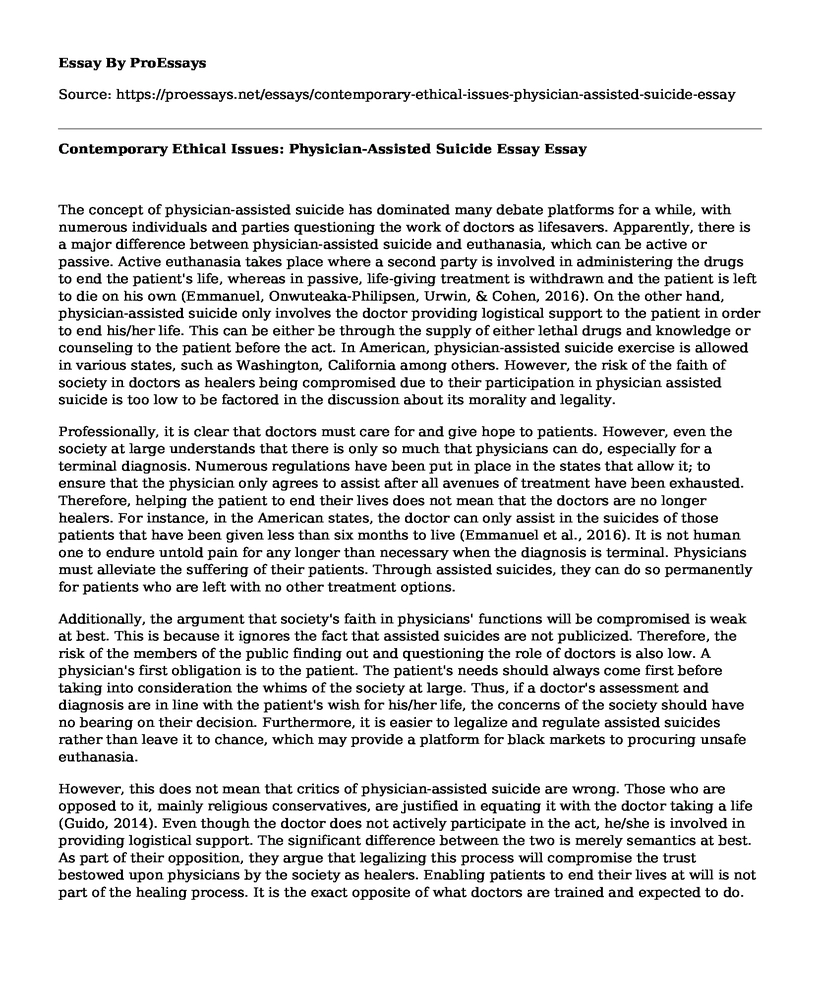The concept of physician-assisted suicide has dominated many debate platforms for a while, with numerous individuals and parties questioning the work of doctors as lifesavers. Apparently, there is a major difference between physician-assisted suicide and euthanasia, which can be active or passive. Active euthanasia takes place where a second party is involved in administering the drugs to end the patient's life, whereas in passive, life-giving treatment is withdrawn and the patient is left to die on his own (Emmanuel, Onwuteaka-Philipsen, Urwin, & Cohen, 2016). On the other hand, physician-assisted suicide only involves the doctor providing logistical support to the patient in order to end his/her life. This can be either be through the supply of either lethal drugs and knowledge or counseling to the patient before the act. In American, physician-assisted suicide exercise is allowed in various states, such as Washington, California among others. However, the risk of the faith of society in doctors as healers being compromised due to their participation in physician assisted suicide is too low to be factored in the discussion about its morality and legality.
Professionally, it is clear that doctors must care for and give hope to patients. However, even the society at large understands that there is only so much that physicians can do, especially for a terminal diagnosis. Numerous regulations have been put in place in the states that allow it; to ensure that the physician only agrees to assist after all avenues of treatment have been exhausted. Therefore, helping the patient to end their lives does not mean that the doctors are no longer healers. For instance, in the American states, the doctor can only assist in the suicides of those patients that have been given less than six months to live (Emmanuel et al., 2016). It is not human one to endure untold pain for any longer than necessary when the diagnosis is terminal. Physicians must alleviate the suffering of their patients. Through assisted suicides, they can do so permanently for patients who are left with no other treatment options.
Additionally, the argument that society's faith in physicians' functions will be compromised is weak at best. This is because it ignores the fact that assisted suicides are not publicized. Therefore, the risk of the members of the public finding out and questioning the role of doctors is also low. A physician's first obligation is to the patient. The patient's needs should always come first before taking into consideration the whims of the society at large. Thus, if a doctor's assessment and diagnosis are in line with the patient's wish for his/her life, the concerns of the society should have no bearing on their decision. Furthermore, it is easier to legalize and regulate assisted suicides rather than leave it to chance, which may provide a platform for black markets to procuring unsafe euthanasia.
However, this does not mean that critics of physician-assisted suicide are wrong. Those who are opposed to it, mainly religious conservatives, are justified in equating it with the doctor taking a life (Guido, 2014). Even though the doctor does not actively participate in the act, he/she is involved in providing logistical support. The significant difference between the two is merely semantics at best. As part of their opposition, they argue that legalizing this process will compromise the trust bestowed upon physicians by the society as healers. Enabling patients to end their lives at will is not part of the healing process. It is the exact opposite of what doctors are trained and expected to do.
Conclusion
To sum up, it is clear that physician-assisted suicide is only done when it is in the best interests of the patient, and according to their wishes. Therefore, the feelings of society should be relegated to the periphery when making this decision, since it is unlikely to tamper their faith in with doctors, as lifesavers, will not be shaken. Consequently, just as the case of abortions, physician-assisted suicides should be left to the discretion of the patient and his/her doctor.
References
Emanuel, E. J., Onwuteaka-Philipsen, B. D., Urwin, J. W., & Cohen, J. (2016). Attitudes and practices of euthanasia and physician-assisted suicide in the United States, Canada, and Europe. Jama, 316(1), 79-90.
Guido, G. W. (2014). Legal and ethical issues in nursing (6th ed.). Upper Saddle River, NJ: Prentice Hall.
Cite this page
Contemporary Ethical Issues: Physician-Assisted Suicide Essay. (2022, Mar 29). Retrieved from https://proessays.net/essays/contemporary-ethical-issues-physician-assisted-suicide-essay
If you are the original author of this essay and no longer wish to have it published on the ProEssays website, please click below to request its removal:
- I've Been to the Mountain Top Analysis Essay
- Pneumonia in HIV-Infected Patients Essay Example
- Essay Example on Older Adults: Mental Health Challenges & Health Promotion
- Essay on Unravelling Qualitative Research in Nursing: Analysing Approach, Interpretation and Presentation
- Essay Example on Revolutionizing Medical Care: The Power of Medical Imaging
- Essay Example on Women's Health: A Growing Concern Worldwide
- Sensitive Quality Indicators - Essay Sample







